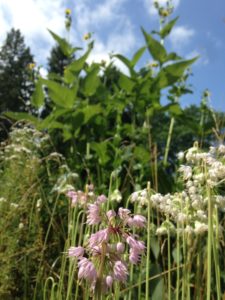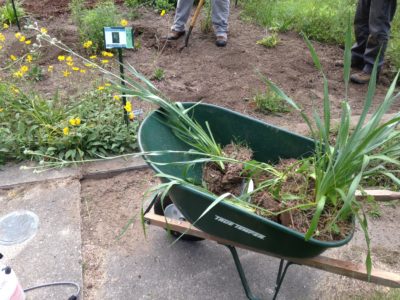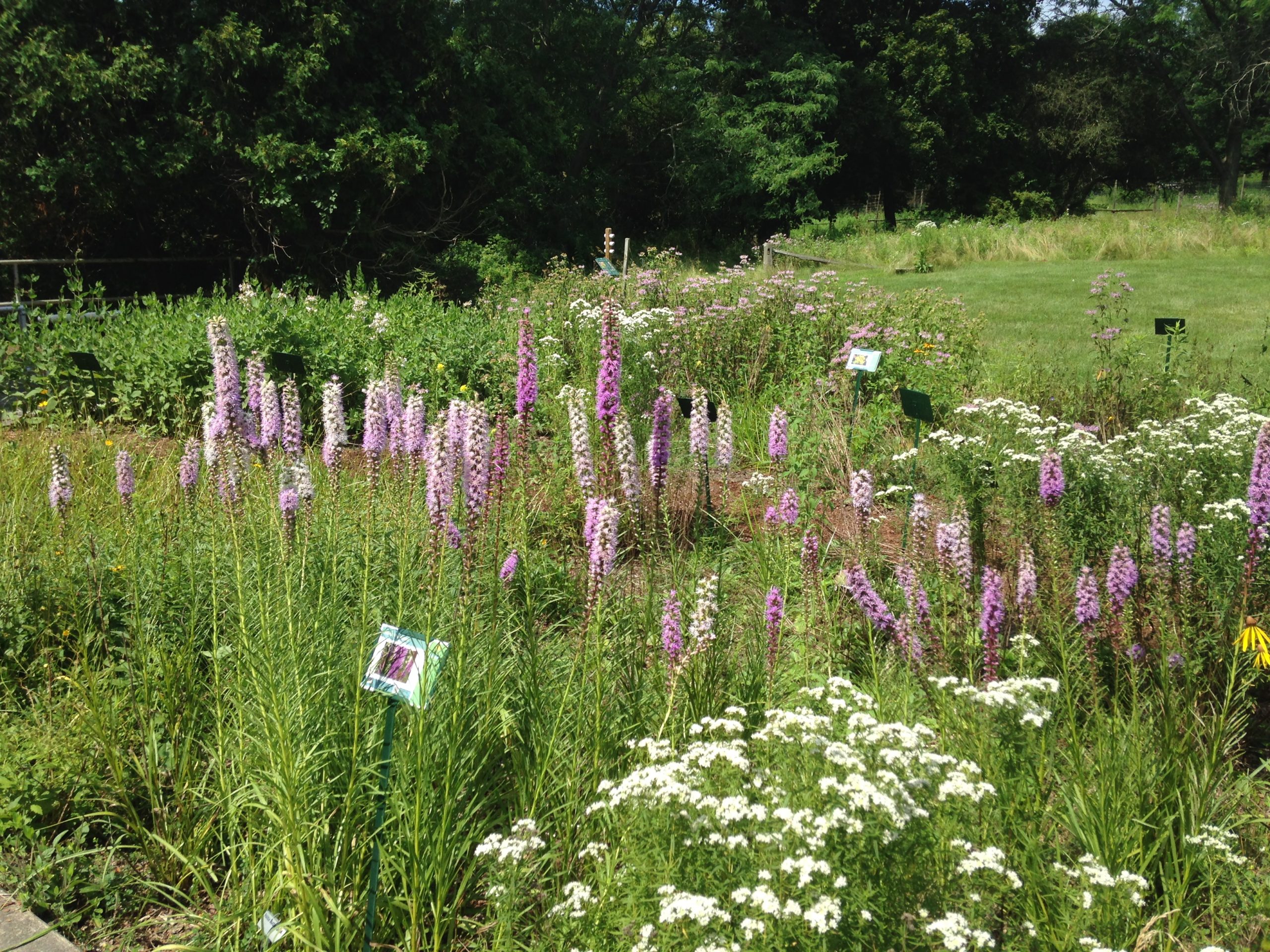
Nodding wild onion (Allium cernuum) and cup plant (Silphium perfoliatum) add structural diversity at Capital City Bird Sanctuary. Photo by Linnea Rowse.
What is a native plant?
Native plants are those that are naturally found in your geographic region and have developed along with other plant and animal species in an ecosystem in a balanced way. For example, some native insects have very close, specialized relationships with a plant species: think of monarchs and milkweeds. Milkweeds have developed a chemical defense against being eaten by herbivores and many insects, but monarch caterpillars in turn have developed detoxifying mechanisms that allow them to eat and survive on milkweed plants. The alternate side of this relationship is that monarch caterpillars are unable to consume other types of plants, because their relationship with milkweed is so specialized.
Non-native plants are those that evolved in other parts of the world, and do not exist in nature in our local areas. Non-native plants may become invasive, spreading quickly and displacing native plants, and disrupting a balanced ecosystem. Non-native plants, invasive or not, are also an issue for our native birds and insects because they do not have the same nutrients, and may have different chemical defenses (e.g. a native insect may not be able to digest the leaves of a non-native plant). Certain berry-producing plants that are non-native do not contain the appropriate nutrients that our bird species need in order to put on enough fat (which, for migratory birds, equals fuel) for long migratory journeys.
Why do native plants matter for the birds?
We’ve lost nearly 3 billion birds since 1970, a net loss of 29% or 1 in 4 birds. This is a major issue and is extremely concerning. Habitat loss is a big factor in bird population declines. Whether this is on the breeding grounds, wintering grounds, or during their migratory journeys, birds are losing habitat throughout their life cycle. Often, we think about habitat conservation happening at parks and preserves, but birds are using the same spaces that we as people are using in our communities. We need to preserve and enhance what habitat we have left in our communities, and create more habitat when and where we can – a lot can happen in our own yards and gardens to help birds!

Rattlesnake-master (Eryngium yuccifolium) transplants, to add diversity into the native plant garden at Capital City Bird Sanctuary. Photo by Linnea Rowse.
Birds need three main components for healthy habitat: water, structure, and food. While non-native plants may provide the structure birds need for nesting or cover to rest or hide within, non-native plants simply do not provide the food needed by birds. When we talk about food for birds, one of the most important food sources is insects – especially for breeding birds. 96% of North American songbirds feed their young insects and most importantly caterpillars, which are high in protein and easy for nestling birds to eat. One pair of Black-capped Chickadee needs 5,000 to 9,000 caterpillars to raise one brood of nestlings. Where will these chickadees find that many caterpillars?
The most important place to start in supporting birds and pollinators is with native plants. We have essentially taken it all – with urban and suburban development (think mowed lawns, paved surfaces) and intensifying agricultural practices. We have taken and modified for our own use between 95 and 97 percent of all land in the lower 48 states1. If every person with a yard is able to convert half of their lawn, or even just a small corner, to native plants, collectively we will all make a huge, positive impact for the birds.
Thinking back to that chickadee family, they are going to find the food they need on native plants – native trees in particular. Native plants support more than 35 times more caterpillar biomass than non-native species (e.g. comparing a native oak to a non-native gingko tree)1.
Let’s make some connections here. We’ve talked about birds needing insects, and insects needing native plants. Plants are the foundation of the ecosystem; they capture the sun’s energy and turn it into food for animals. The vast majority of animals eating plants are insects, which are then eaten by many other animals, including birds.
Birds need native plants!
Our birds face many threats, but we can help in our own backyards! We can reimagine our yards to provide safe, healthy native habitat for birds throughout the year. Where will you start?

Learn more with these resources:
Online Resources
Information about native plants, including suggested Michigan native plant sources: michiganaudubon.org/bfc/bird-friendly-plants/
Michigan Native Plants for Bird-friendly Landscapes booklet: michiganaudubon.org/wp-content/uploads/2016/04/MI-Native-Plants-for-Bird-Friendly-Landscapes_Website.pdf
Michigan Native Garden Design for the Birds: michiganaudubon.org/wp-content/uploads/2018/03/Michigan-Native-Garden-Design-for-the-Birds.pdf
National Wildlife Federation native plant finder – use to find native plants specific to your area: https://www.nwf.org/NativePlantFinder/
Bringing Nature Home website has a wealth of information about the connection between native plants, insects, and birds: bringingnaturehome.net/
3 Billion Birds offers information about global bird declines and actions you can take to support bird populations: 3billionbirds.org/
Books
Bringing Nature Home by Doug Tallamy
Landscaping with Native Plants of Michigan by Lynn Steiner
References
1Tallamy, D. W. 2007. Bringing Nature Home: How Native plants Sustain Wildlife in Our Gardens. Timber Press. Portland, Oregon. 2nd ed. 2009.
~ Written by Linnea Rowse
Michigan Audubon Conservation Program Coordinator


